The backend (in other words the server-side) of an application or a website is something invisible to the eye of the user. It’s a tech layer responsible for storing and organizing data that controls all functionalities and ensures everything on the client-side works without errors. The backend also communicates with the frontend (the layer visible to users) sending and receiving information to be displayed as a web page.
The server-side can be built using many different technologies that will provide the necessary performance and security of the product. The important part is to choose a backend technology that will correspond well with the chosen frontend. In our case that would be React.js, one of the most popular JavaScript-based technologies.
The Javascript library was originally developed and used by Facebook developers until in 2013 the tech giant decided to make it open-source. Soon it was used by the biggest companies worldwide like Google, Facebook, or Netflix. React.js revolutionized the way developers build apps and allows them to create remarkable UI components. You can read more about why we base our work on React.js here.
React.js is a part of the tech stack in multiple projects of different sizes. Let’s see what backend technologies are usually chosen by developers having React.js as frontend technology.
React Native was released in 2015 and is a JavaScript framework – a platform for native mobile application development. As the name suggests, it’s related to React.js as it was actually based on it. The combination of these two technologies gives an application a boost in the form of great performance but also a great user experience for mobile device users.
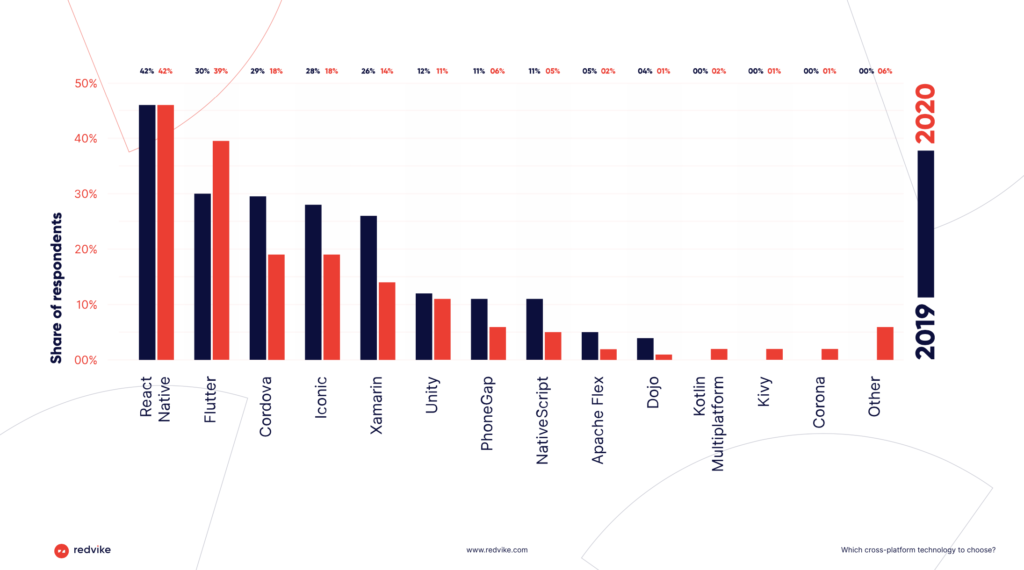
React Native offers a range of innovative features such as hot reloading of which you can read here.
PHP, Java, Python – these three are solid backend technologies we all know about. But what about JavaScript? It’s a programming language known as full-stack technology. JavaScript may be used for developing both – the frontend and the backend of an application. Sounds good right?
Node.js is a server-side runtime environment based on JavaScript. Which means it’s not a programming language nor a framework. It’s an environment that’s built on a JavaScript V8 engine that adapts JS functionality and syntax to backend development. Combining React.js with Node.js allows developers to build applications that are isomorphic; the communication between the client-side and server-side of the application is fast and efficient.
Find out which famous apps were built with Node.js
React can be often seen paired with Django – a high-level Python-based framework for backend development that is also open-source. The main advantage of Django is scalability – it can be used for building both simple projects and complex solutions capable of handling heavy traffic and large volumes of data.
There are voices that say the two have nothing in common, however, both technologies are used by Instagram. What’s more, many developers state that if a web framework can respond to HTTP requests with JSON and HTML, it can be used with anything.
There are enough reliable backend technologies available for you to choose one for your React application. Choosing the right backend and frontend technology will help you save your resources and work more efficiently. As there are so many options, you should carefully consider your needs and expectations regarding your product.
Our Redvike team will be happy to advise you on the appropriate tech stack for your application. Contact us to learn more about what we can do for your business.
EdTech developers provide solutions that offer tremendous opportunities for the education industry. Using today’s technology they are able to create an immersive learning experience in a compact form of an application. Some of the products are amazing in helping people to expand or improve their skills. They can track students’ performance and motivate them to be better in their field. Part of the success is a product strategy and great UX design but what’s taking the lead in educational apps is, of course, technology.
Without the good back-end and front-end technology, an app wouldn’t be able to provide the users with expected performance. Without all the modern tricks such as gamification or voice recognition, it just wouldn’t be an app from this age. That’s why it’s important to choose the right technology for your EdTech solution. At the heart of Redvike lays all of the React family. That’s why today we’re going to focus on some of the best educational apps built with the use of the JavaScript library – React.js.
It’s not just about school education. There is a clear trend towards learning through educational content shared on the most popular social channels. A good example is what’s happening on TikTok – the fastest growing social media app for creating, sharing, and discovering short videos. In May 2020 TikTok has announced its plans to encourage its community to self-educate by launching a new #LearnOnTikTok platform. The plans include collaboration with experts from various institutions who will be responsible for creating educational content.
With the Internet availability, the increase in smartphone use, and the growing popularity of social media, eLearning has the best conditions to finally be recognized and developed on a big scale. However, if we want to deliver useful content that inspires, and drives engagement, we should base our product on modern and reliable technology.
It turns out that behind some of the best eLearning platforms there is a well-chosen tech stack – including React.js, that holds it all together. Here are five great educational apps we’ve picked that use the power of the JavaScript library.
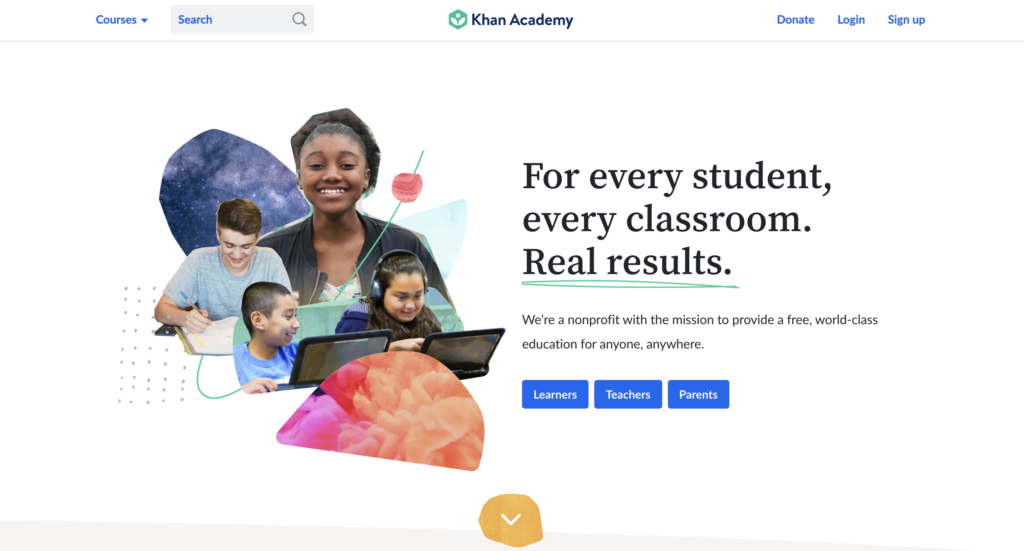
It’s an American, non-profit EdTech organization established in 2006 by Sal Khan that produces educational content for students and educators. Their online platform is filled with short videos, supplementary materials, and useful tools to enhance the learning experience.
Khan Academy underwent a major upgrade to React.js which provided the platform with smooth element changing and the elimination of unnecessary re-renders. What’s more, in July of 2020 the platform finished a complete migration to React Native. The reason for that was the challenges of maintaining two codebases with a small mobile team. By making a switch from Backbone to React technology the organization is able to introduce changes to their app in a more efficient way, eliminating the number of errors and cutting the time of development.

Skillshare is an online learning community sharing thousands of inspiring classes on topics including illustration, design, photography, video, freelancing, and more. The company was
founded in 2010 and has its HQ in New York. This type of on-demand learning has recently gained a lot of recognition in the US thanks to the personalized approach and the spectrum of available classes.
Skillshare offers incredibly engaging content that attracts the right audience. The EdTech platform was built with the use of React.js which supports the smooth interaction of UI elements and the creation of a user interface that enhances learning.

Sana Labs is a global leader in the development and application of AI to learning. One of their core products helps users improve pronunciation when learning a new language. Their all-in-one learning platform has a built-in AI mechanism and analytics that tracks the user’s performance – it was developed in a collaboration with our Redvike team.
We built a responsive React.js app using Sana’s eLearning API, to provide the company with a showcase of their technology and highlight the power of their solution. The React.js product has become a vital sales and marketing tool for Sana. The company also won a CogX award for the Best AI Product in Education.

Who doesn’t know Duolingo? Duolingo operates as an augmented reality app embedded with a multilingual chatbot, to improve speech recognition capabilities. The language learning app appeared in the market in 2011 and in just two years earned the title of iPhone App of the Year. Certainly, it’s one of the most popular educational apps and also the one built with the use of React.js.
The frontend of Duolingo was written in Backbone.js and Mustache but is now primarily in React and Redux. The use of Javascript library enable the app to capture the attention of users with its highly responsive UI components, transitions and navigation that guarantee remarkable user experience.
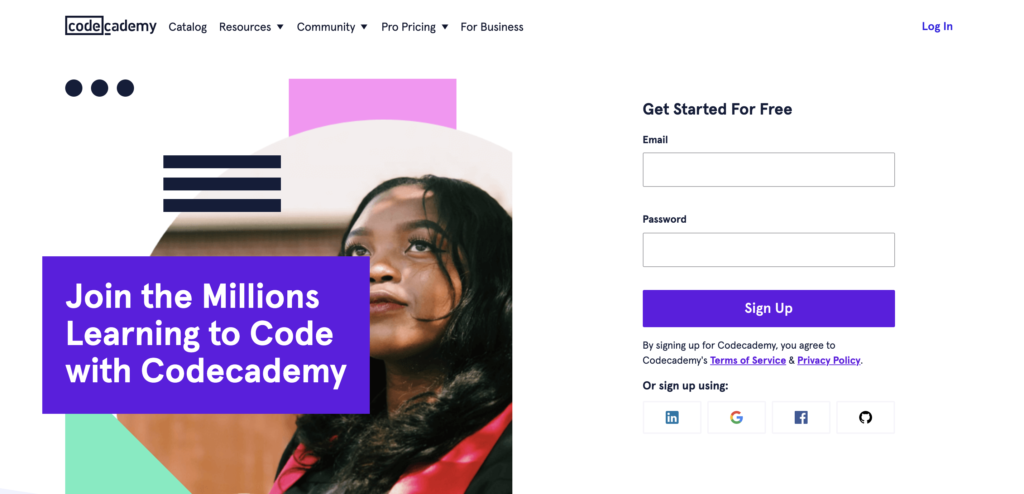
Lastly, an American educational app offering free coding classes in 12 different programming languages including Python, Javascript and Java. As a web app designed specifically for developers wanting to learn or improve their coding skills is a great position in the Edtech app category.
In August 2014, Codecademy decided to fully incorporate Facebook’s library, and till this day React.js is one of the key scripts included in the app. The company’s team admits that there are a few things they appreaciate the most in React.js. They include the battle-tested script, compatibility with legacy code, flexibility and the way it cooperates with SEO.

React.js is widely applied in the EdTech industry. It supports the user experience in most advanced and popular educational apps in the market. Its features were recognized by global leaders and innovators not only in the field of eLearning but also by pioneers in AI technology.
One of the reasons is for sure the performance it provides. Above all, it’s reliable and supported by a tech giant – Facebook, technology that when incorporated into your digital product, saves a lot of in-house resources while attracting more users to your app.
React technology is literally the heart of our company. Since the beginning, we’ve been creating web and mobile applications this way as we value scalable and modern solutions. Knowing the framework inside out today we share some good resources to learn React Native. Enjoy!
React Native breaks records. The JavaScript framework has not only gained recognition among all developers by being on the top of the favorite cross-platform technologies but also more and more often takes a significant place in the tech stack of global brands. Thanks to its innovative features, it’s superior in comparison to competitive technologies and its rapid development ensures high demand for specialists in the market.
If you ask a developer how to learn something there are high chances you get a response “read the documentation”. We recommend that too as the best way to understand how something works is to study its functionality and logic behind it. Fortunately, React Native has its documentation written in a simple and accessible language.
You can find it here: https://reactnative.dev/docs/getting-started
The most obvious point on the list are all kinds of online workshops where you can learn coding following a crash course. There are plenty of courses on Udemy offering React-based lessons. Among all the availble tutorials we picked up a few that we think are useful:
The Complete React Native and Hooks Course. Here it’s a 2020 edition but sooner or later there will be a new one for the upcoming year. This course will help you understand the fundamentals of React, the terminology, concepts of Redux but also it will teach you how to quickly build a prototype and deploy your own applications to the Apple and Google Play Stores.
Build Full-stack React Native Apps with Express.js Backend. This one is more practical as at the end of this course you will know how to build 4 apps using Redux, React Navigation, MongoDB, Node/Express. The workshop is more on a medium level so it’s not the best choice for beginners but on the orher hand, if you learn better through practice, go ahead!
React Native: Advanced Concepts. When you finish the two previous courses, you can start with something more advanced. In this course you will learn how to build React Native apps with Expo, create eye-catching animations, use expert-level features of the framework, use React navigation to the full, add logic to your Firebase backend with Google Cloud Functions, engage users with Push Notificatiosn and use Redux Persist.
When it comes to literature, a good complement to online courses will be a book called FullStack: React Native. It’s a complete guide to React Native that covers everything from components to the deployment. For sure it will give a meaning to all the stuff you’ve learned so far during online workshops. Another great reading is Pete Hunt’s tutorial about ReactJS – Thinking in React. It’s more for the better understanding of React logic and the components machinery.
Don’t forget to check our blog where we often publish useful content about React and React Native. Here are some of the posts you may find useful:
What’s new in React 16.6 and 16.7
Regardless of whether you are a React geek or a beginner, the resources will help you get through the basics of the framework and end the journey with some solid practical experience. We hope you will get use of our knowledge base as well 🙂 Good luck!
You can also read:
What is React Native used for?
Top 5 companies using React Native
If you follow the latest trends in the app development sector, you know that React Native vs Xamarin is a common battle. They share a spot on the list of top cross-platform technologies. They both provide an environment for convenient development of products on multiple platforms at once. However, they have different functionalities which may be more useful or less, depending on the project.
Let’s explore the characteristics of the two cross-platform technologies and discover when it’s good to switch to one or the other.
We’ve already talked about what is React Native used for and how the framework makes everything easier. Let’s quickly sum up its history.
React Native is a JavaScript framework brought to us by Facebook. It’s an open-source tool that enables developers to create apps with a native-like feeling. The technology has earned the number 1 place on the list of top cross-development frameworks of 2019 and 2020. Because it’s quite young (released in 2015) it meets most expectations from developers and has a pretty extensive coding society.
On the other side of the ring, we have our old friend Xamarin.
Xamarin is also an open-source framework but it operates on C# and .Net instead of JS libraries and HTML. The framework allows for building apps for Android, iOS, and Windows, enabling sharing approx. 90% of app code across all platforms. It was released in 2013 by Microsoft and since then provides developers with a technology responsible for managing communication between shared code and platform code.
What matters for either developers or product owners is the performance, coding environment, development costs, and possible community support of a given technology.
React Native lets you build apps with lightning speed processing, highly responsive UI, and great overall performance almost identical to native mobile apps. However, the framework doesn’t support 64-bit mode on Android.
Xamarin wins one category as it fully supports 64-bit mode and it runs the fastest code on Android and iOS. Xamarin apps also are of high-performance with native-like feeling as it uses platform-specific hardware acceleration.
React Native is very flexible when it comes to choosing your development environment. As a developer, you can select any IDE (integrated dev. env.)/text editor for your work choosing from dozens available on the Internet. Atom, Sublime Text, Visual Studio Code, GNU to name a few. What’s important here is that React Native has a powerful feature called Hot Reloading. It basically means developers can see changes in the code in real-time without the need to fully reload the app. Cool stuff!
Xamarin has more to offer as it allows you to build apps in Visual Studio Code and Apple’s XCode. Choosing this framework you can write code for an iPhone app on Windows and then compile it for Mac. Visual Studio provides many useful tools and layouts to make your app works just better and it generally simplifies the whole process.
React Native capabilities were appreciated by the vast majority of developers worldwide. Because of that, the technology has a pretty extensive coding community around, ready to educate others and share knowledge about working with the framework. If you want to learn React Native, there are tons of materials available online including not only articles but also whole courses and tutorials!
Xamarin is two years older than React Native but since it’s not that popular there will be fewer people operating actively on the technology today. But if you’re looking for experienced Xamarin developers ready to help you with the code, you can find them on forums, Stack Overflow, or QA sites.
The only thing that makes React Native wins this category is the fact that enterprises have to pay for Visual Studio in order to use Xamarin, while React Native is an open-source framework = free for everyone!
The choice of what to work with lays in your hands. We collected the key information about both technologies to help you see the bigger picture. Overall, both Xamarin and React Native provide great functionalities and environment to build high-performance apps.
If you work with JavaScript and React developers then React Native will suit you well and those who love C# will probably get friends with Xamarin pretty quickly. But there’s really no rule for it. Remember that by choosing the framework on the basis of your current project specifics you’ll never go wrong!
React Native earned no 1. place among the most used cross-platform mobile frameworks of 2019 and 2020. According to statistics, 42% of software developers worldwide use React Native as their main framework for mobile app development. And it’s not a surprise as the technology offers a long list of advantages that accelerate the work on a project and ease the life of developers. Here are some of the most innovative features of React Native Development.
Mobile app development is a complex process that requires an investment of time and money. When we base an app on modern, powerful technologies like React Native, not only we can speed up the whole process but also reduce the costs associated with it. The capabilities of React Native Development are very impressive that’s why the technology gained so much popularity over the years. But if the framework is new to you check out our article What is React Native used for?
The reason why this technology is so popular is the range of innovative features it offers.
React Native enables developers to build a codebase that can be reused on both iOS and Android. It means, they don’t have to build a separate app for each platform. Instead, they can use the same code and accelerate product development. Also, if a company has already developed its web app, most of its code can be used to develop a mobile app (if it was built in React). Adding up lots of prebuilt components and open-source library, the whole process goes incredibly fast and code reusability ensures there are fewer inconsistencies between two platforms.
Live updates are another innovative feature introduced by the framework. Native app development requires manual upload of the new version to the App Store or Android Play. Only after the stores approve the changes, the update is available to users and they have to install it on their smartphones. React Native development requires no such actions. An update runs locally either by using JavaScript files embedded in the app or by fetching the latest changes from a server. It means that an update is released immediately.
Native apps work faster and more smoothly but the cost of the development is high if we want to support it for both platforms. React Native enables you to build an app that offers a native-like performance as most of the code applies to iOS and Android. It’s a big saving in time and investment when we can achieve two things at once and stay native. Same things when we want to push updates – we can do it simultaneously on all platforms.
An app built with React Native has much to offer when it comes to user experience and user interface. Thanks to React JavaScript UI, the app is more responsive and has a decreased load time which greatly contributes to the level of user experience. With React Native you can build an app that has simple UI but that’s what makes it powerful and attractive to users.
Since technology is rather young, there are features that are yet to be developed. For this purpose, the framework supports the thrid-party plugins which are the Native Modules and JavaScript Modules. If you build a React Native app and want to integrate it with Google Maps or other Google tools you can do it with the help of plugins and apply all the necessary features in a convenient way.
The technology turned out to be a great choice for many top-shelf companies. Check out what are the top 5 companies using React Native.
The ability to develop a code that is compatible with all platforms can be a game-changer for a business. Cross-platform development increases the productivity of the whole project team thanks to the innovative features. Not to mention how much a company can save just by choosing React Native development.
Code reusability, lots of prebuilt components, and facilitated testing phases. It all makes the product reaches its final stage way sooner and is ready to enter the market. It’s the speed that gives your company an advantage as in such a short period of time, your app is fully prepared to be used by customers (on both platforms!).
Since you can code for two platforms at once, you don’t need to hire a room of react native developers. Depending on the complexity of your project you may need just 2 or 3 specialists in this field. A smaller team means lower costs of development. Also, the whole process takes less time as React Native greatly eases the work of developers. For you, it means less money invested in the project.
The framework is based on well-known and established through years – JavaScript. It won’t be a problem for a business owner to find developers experienced in this programming language. What’s more, React Native is a community-driven technology with an open-source environment. The benefit for your company is that all the data and documentation of the framework are available for everyone.
If you want to create a product that melts the hearts of customers with remarkable user experience, we are ready to deliver it! Only by choosing to base your app on React Native, you gain a huge advantage from the speed of development and the low costs of maintenance. We will guide you through the whole process and show you possible solutions so your product benefits more people. Let’s talk about your idea!
It’s not easy to get your way around swimming in the sea of mobile app development companies. The choice is pretty satisfying but what’s with the quality? Not every company will meet your expectations regarding the final product. That’s why we want to guide you through the IT world and help you identify the best mobile app development company.
Mobile apps have become the most accessible channel to share content and experience with customers. No matter the industry in which your product will be growing and attracting customers, there are some things common for all mobile apps. To build a product from your dreams you need a group of professionals who also understand what an app should offer to its users.
Before you start searching for a company to build your mobile app get familiar with 10 things you need to be sure while building a product. It’s better to first educate yourself, to know what kind of questions you may receive during a meeting. Below there are criteria on which you should base your final choice.
First of all, you have to check the company’s expertise in building mobile applications. You don’t want to work with people who don’t specialize in this kind of solution but “will try”. How to identify their professional experience? Start by exploring their portfolio and their completed projects to see if they’ve already delivered something similar to your idea. See what kind of problems the team encountered during the development process and how they solved it.
Then try to find as much information about the company as you can, for example how long the company is on the market, what kind of clients they work with, etc. This way you will identify if the company is reliable and ready for your challenge.
Here, you need to first define what’s your expectations regarding a mobile app. Do you want to build a native app or a PWA, maybe hybrid? What platform you choose for your product – iOS or Android. If you want to base your solution on advanced technology such as AI or Blockchain you have to look for a company that also specializes in these kinds of solutions. For example, at Redvike we offer Cloud Services that can speed up your time-to-market.
Mobile app development technologies have evolved to the point you may not know which one is most suitable for your product. That’s why we want to introduce you to React Native mobile applications and their fantastic, incomparable performance. React Native is the answer to all problems connected with costs, time, performance, and scalability. It’s a technology that enables you to develop the same mobile app for both iOS and Android in half the time. This way cutting the costs associated with mobile app development and ensuring fewer inconsistencies between both platforms. Read about the top 5 companies using React Native that increased their app performance.

The cost of development always depends on the complexity of a product. Because the complexity also determines how long it will take to build a mobile app. There are also other factors that influence the final cost such as the size of the team or the type of an app (native, hybrid, PWA). There isn’t a fixed price for a software product and the best mobile app development company would only charge you for the number of hours worked. This way you pay less for a product that includes basic functionalities and you pay more for a complex one.
To visualize the range of costs of mobile app development, a single hour of a developer’s work can cost you $11 in Indonesia and $150 in North America. For many, the Golden mean is Eastern Europe when the price of development is proportional to the quality. You can always find the average costs on Clutch.co. But if you want to save on the development process you should seriously consider a hybrid app.
You want to create your own product so the process of building it should not make you worry. The company you collaborate with needs to represent your values and be aware that you, as a client, have the right to know what phase the product is. That means – transparency of communication. The best mobile app development company is the one that keeps you always updated about the progress and has nothing to hide, giving you access to the project under development.
The next thing is the methodology of work. How the company’s work model looks like. Are they Agile? It’s important that the mobile development company you work with is aware of the importance of testing stages and the general software development life cycle. We wrote about the 4 stages to build a perfect mobile app here.
No one is more credible than the company’s clients. The last thing you can do to verify the reliability and expertise of a mobile app development company is to see their online reviews. By this, I mean not only the client testimonials but also ratings and the number of downloads of mobile applications that the company has built.
Your product will shine only when it’s been developed by the right people. Through this article, we wanted to help you find the best mobile app development company that is trustworthy and won’t disappoint you with the outcome. If you currently looking for mobile app developers ready to craft your vision into a real product – contact us and let’s get to work!
With the ever-rising popularity of React Native, we could notice some great examples of applying the technology into products. Despite being rather recent, it’s been already used by many startups and enterprises of various sizes and from different industry sectors. From all the examples we distinguished a list of top 5 companies using React Native. Do you want to know why they decided on that technology? Keep reading.
From our previous article, you could learn about What is React Native used for. Today we want to find the reason behind the choices of 5 companies that decided to use React Native for their products.
React Native performance was appreciated by Walmart, a company that was once the world’s largest online retailer. Walmart wanted to build a hybrid app. It’s an app that is based on a part of the native code and the part that is built using a cross-platform technology (i.e. React Native). They already had mobile apps but needed to rewrite them for both Android and iOS.
Since React Native enables code reusability, the company’s developers could optimize their work by making changes only for one operating system. With 95% of the codebase being shared between platforms, the company reduced their costs by half and greatly increased the organization. The software developers were able to leverage their experience with web technologies to create mobile features and the overall work was very convenient thanks to instant page reloads, ready-to-use components and Over the Air (OTA) code push to fix critical issues. Deciding to use React Native, Walmart achieved great development performance and could improve customer experience. Up to this day, Walmart’s mobile apps are almost entirely based on React Native.
Another React Native example is Pinterest, a social media platform that’s based on sharing creative content to users. With billions of Pins available on the app, users can always find inspiration in the form of graphics or videos. The content is constantly shared, updated, and added to users’ personal folders. That’s why Pinterest has to work flawlessly and meet performance expectations.
In order to achieve that, the company decided to use React Native technology. The initial implementation on iOS alone took the engineers about 10 days. Next, in two days the team was able to transfer it on Android with 100% UI code being shared between platforms. Using React Native, Pinterest saved hundreds of hours on the development process. Also, code reusability ensured there were fewer inconsistencies between the iOS and Android versions.
Among the top 5 companies using React Native, there is also UberEats. Uber created the app with the aim to facilitate the food delivery process. Also, the app enables people to become a delivery partner of restaurants and earn money through food delivery. What was the challenge in the project was to connect restaurants, drivers, and customers.
The development team had to translate the existing restaurant dashboard from web to mobile version (iOS and Android). The only right move was to do it with the use of React Native magic. Code reusability but also Live Reloading and cost efficiency were saviors in this sort of undertaking. One of Uber’s software engineers mentioned the benefits of the framework’s capacity for expanding the service.
Bloomberg is a media company that provides global business and finance news but also delivers software solutions for enterprises. Their mobile app was to provide the same experience and access to information as if users were using the web version of the platform. What’s more, Bloomberg was spending a lot of time updating both iOS and Android app individually. React Native was a perfect solution to speed up the update cycle and further mobile app development.
The React Native performance enabled the company to not only rebuild their mobile app on both operating systems but also add a lot of new features to the offer such as live TV access or experience personalization. React Native implementation also allowed the development team to achieve the continuous update cycle which highly optimized their workflow.
Discord is a free voice and chat app dedicated to gamers, however, a lot of users use it as a social media platform. The app enables users to chat with the team in real-time while playing games. Discord was one of the first React Native apps introduced to the market as the company decided to implement the technology for its iOS app before React Native’s official release in 2016.
Making Discord a React Native platform enabled the company to take advantage of the reusable code and make quick product iterations with just two persons on board in the development team. Discord iOS and Android applications share 98% of the codebase which is a game-changer in cross-platform development.
The above top 5 companies using React Native generated impressive results and reached performance that helped them greatly expand the business. React Native offers companies a lot of benefits throughout the process of implementation and development. By combining the advantages of native and hybrid apps, the technology speeds up the development process, provide native-like experience and a significant cost reduction.
If you need a React Native solution for your company, contact us!
Software developers appreciate technologies that besides offering high-quality outcomes, are also pleasant to work with. That’s why recently, React Native gained so much popularity in the IT field. The technology certainly has much to offer that’s why today we’re going to focus on – what is React Native used for.
To start this in the right way, first, we need to distinguish two technologies:
React js. is a JavaScript library to build powerful and innovative user interfaces. It is also the heart of the React Native functionality. React js. was developed by Facebook to address the needs of high performing UI components. The technology receives big support from the community that continuously works on its development.
React Native is a JavaScript framework that enables creating native mobile applications for iOS and Android. It offers an open-source environment, great portability, and is easy to work with. Using modern technology contributes to minimizing the overall costs of product development and maintenance.
React Native is used for building natively rendering mobile apps that can be simultaneously developed for iOS and Android. Software developers use the JavaScript framework to accelerate product development. React Native is equipped with pre-developed components and its portability eases the whole process of writing an app. It brings high-speed processing, great responsiveness but most importantly – the best user experience to your product. Using the framework Native, companies can produce high-functioning mobile apps that, in the end, are comfortable to use just like the native ones.
As was mentioned at the beginning, React Native is one of the solutions that provide developers with a lot of conveniences during work.
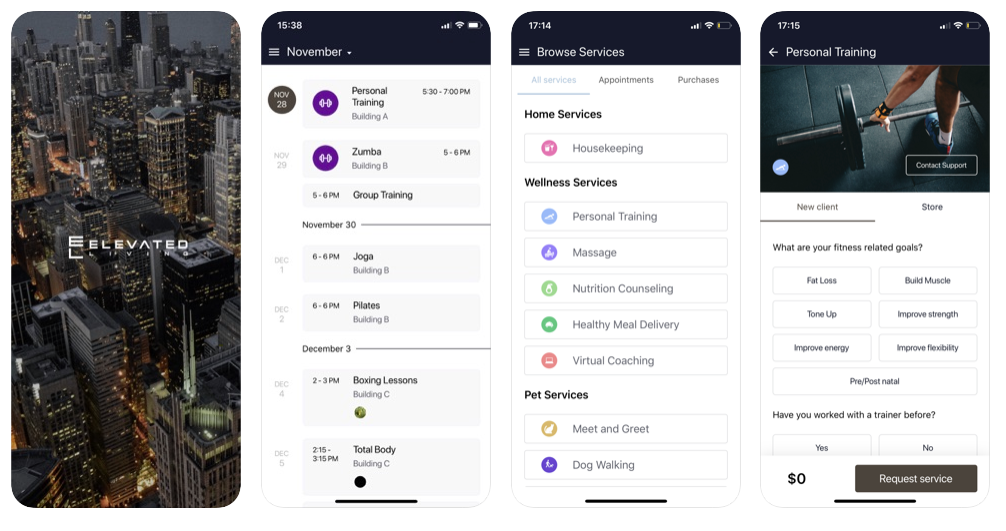
Companies that offer React Native development services are in a center of interest to most tech leaders. The technology offers numerous advantages making React developers valuable on the market. Working with Redvike you get access to a team of skilled, ambitious, and hard-working React developers who can help power-up your product’s performance.
In need of a React solution? Contact us!
In Redvike we always strive to deliver unique mobile apps which provide modern design and amazing user experience. This is usually the main target of our clients who want to persuade people to become paying customers, but that’s only a small part of our work. After reading this short post you will understand how we protect and maintain codebases so it’s extremely easy and fast to add new features in future releases or edit the old ones.
Instead of vanilla JavaScript we use TypeScript during app development. It brings static type-checking along with the latest ECMAScript features. Microsoft designed it with focus on large scale applications which means your app is always prepared to grow without any troubles. In addition it helps us to catch bugs immediately by throwing IDE error messages about possible defects in codebase, with that there are up to 70% less chances for your app to crash or work in the wrong way in production mode.
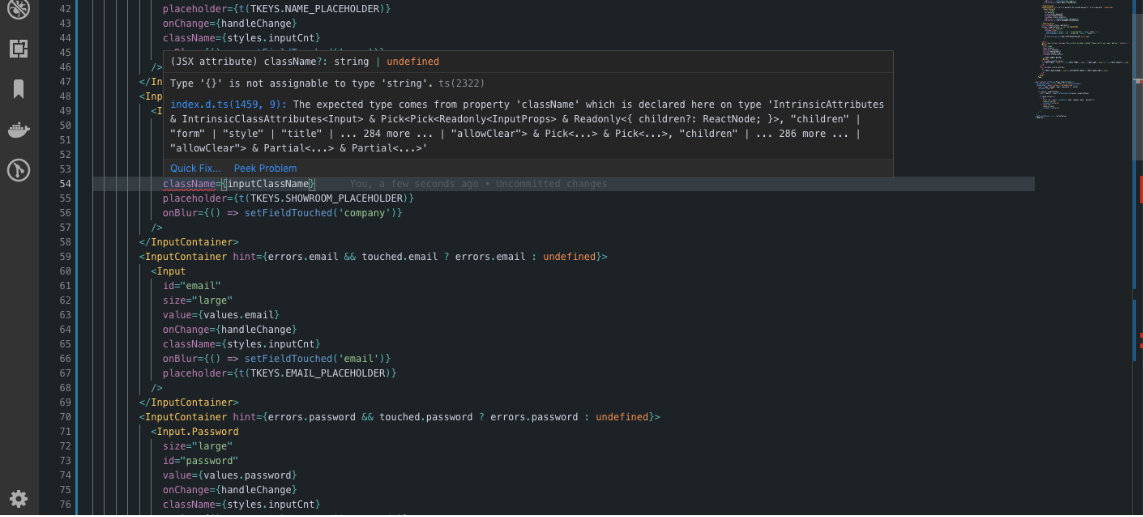
These two tools in combination with TypeScript are truly bug killers. Prettier is responsible for providing consistent code style. It formats our code automatically each time we save the file so it’s a lot easier to read the code. On the other side eslint delivers possibility to setup our own security rules and it is also used by a big companies like for example AirBnB. There are a lot of professional eslint plugins on the market, but we are using a few best one. Some of them are typescript-eslint, eslint-plugin-react and eslint-config-airbnb. With this setup we are always sure that our code is wrote along with the best quality.

We hope everyone know the importance of writing tests during development, this is one of the main parts of our job. Well tested app codebase means no defects in future releases. It prevents from breaking functionalities while adding new ones or editing code. This is the least wanted thing for app owners to add new feature, unexpectedly break something else and push it to the production. To handle this problem we should always spend some time on writing tests. In Redvike we are using React Native Testing Library which provides fast and straightforward way to write unit and integration tests. In addition we test each feature in the way end users will use it.
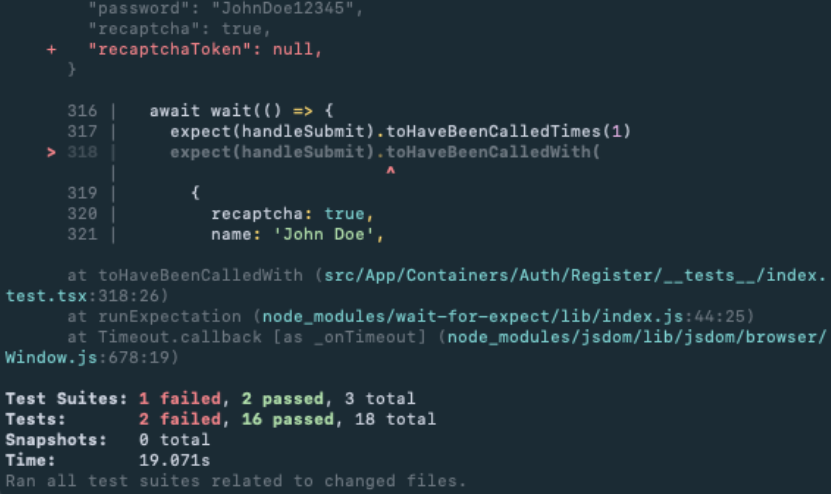
These tools give us a way to run own defined scripts before committing or pushing code to the app repository. This basically means we avoid committing broke code by developers by running pre-commit and pre-push scripts. They check if there is any error received from typescript, eslint or tests, if so, developer is unable to commit and have to fix the code first. Husky is responsible for invoking scripts immediately after git commit or push command, then lint-staged checks which files was added or edited, so we can avoid wasting time on linting untouched files.
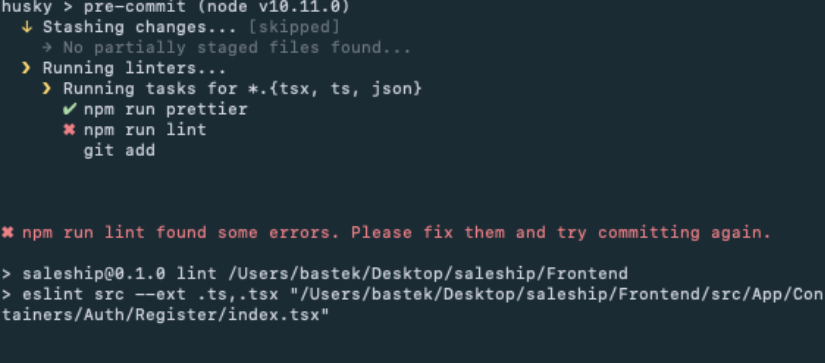
Not enough? No worries that’s not all! Even if all checks from previous steps passed and code went to the repository there is one last step – code review. Each attempt to add or edit code must be reviewed by other developers. They scan code line by line to check one more time if everything is coded along with best practises. On this stage we comment the code and request changes if necessary to be 100% sure that codebase is fine.
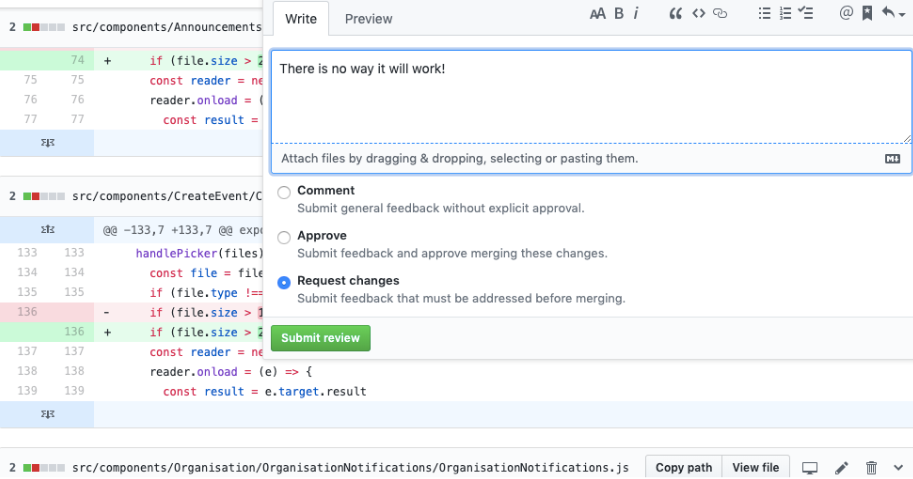
We hope we clarified well our process of code maintenance. So now, it will be easier for everyone to understand how we take care of apps not just from the visual side. There are a lot of ways to handle this problem but we found our approach good enough. It helps us to minimize bug chances every single day!
React Native is responsible for simplifying and fastening the process of making apps for Android and iOS. This frameworks allows to write JavaScript code and simply run it on both platforms. It already featured plugins and extension for targeting Windows and macOS, but there hasn’t been official support from Microsoft itself.
The idea of Microsoft is based on rewriting many components in C++ to get the best performance possible. As well as not limiting usage of the framework just to PCs. It allows developers to make apps for any Windows 10 device – PCs, tablets, Xbox and mixed reality devices. Through this move, Microsoft provides developers with the level of optimization for its ecosystem which hasn’t been available ever before.
Microsoft’s project was released on GitHub and can be tested by developers today. Microsoft is planning to update and develop it in the future versions.
If you want to check it out – here’s the repository.
If you would like to learn more about the possibilites of developing apps for Microsoft’s ecosystem here’s one of our recent articles about building apps for Xbox: Build Xbox with React.
At Redvike we aim to deliver the best React Native apps for our customers around the world. The fact that Microsoft decided to support React Native development is worth notice especially when we build apps for different platforms. It helps us to reduce the costs of development for Windows and be able to make user-experience unified. It means that the way people interact with an app on their phones would be similar to the interactions with the desktop or Xbox app.
Finally, the support of AR devices delivered by Microsoft can be very influential. There are multiple ways in which React Native can help to make AR more accessible for our clients. Even though, we have to wait a bit for official demo to be able to tell more about ways in which AR can be implemented. Before this comes, we invite you to read our last article about React Native – React Native vs. Flutter – Which Is Right for You?